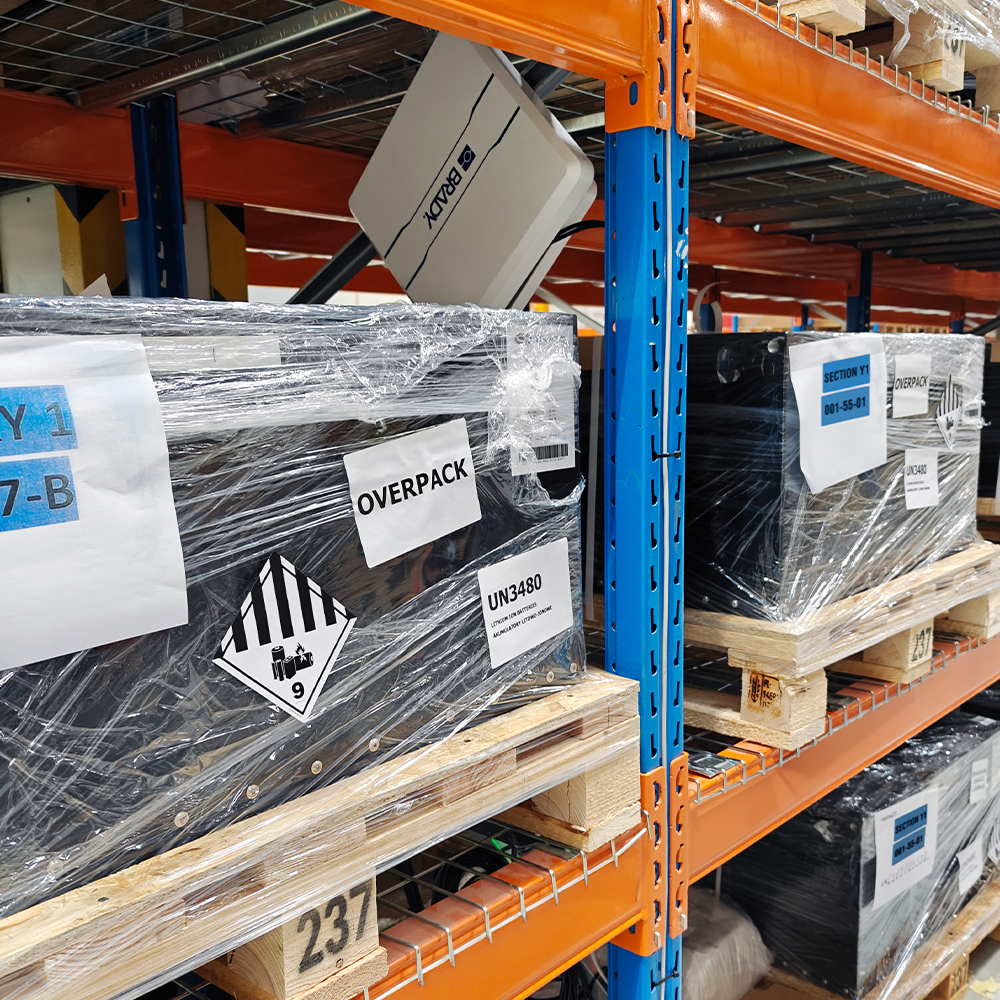To protect its workers and facility, a large battery manufacturer was looking for a cost-effective solution to quickly detect temperature changes in stored lithium-ion battery cells. An unstable Li-ion battery generates heat, is prone to ignite and difficult to extinguish, and could easily cause a chain reaction with high safety risks for personnel, goods and infrastructure.
The company had tried several solutions which proved both expensive and ineffective to monitor temperatures in battery cells, stored in 8 boxes per pallet in 15 metre high racking. Active sensors proved costly, smoke detectors triggered alarms too late, and thermal heat cameras needed line of sight on each battery. Read how Brady helped its customer to answer the challenge of early rising temperature detection.
Solution: Battery-free UHF RFID labels with integrated readers, antennas and software
Off-metal RFID labels with embedded sensor
To detect battery cell temperature changes, the battery cell manufacturer selected Brady’s off-metal UHF RFID labels that can be applied to cardboard boxes in which Li-ion battery cells are stored. The labels feature integrated temperature sensors powered by repeated pings from RFID readers. These sensors accurately measure temperature changes, from 0.5°C upwards. Measured temperatures are sent back wirelessly, and without needing line of sight, to the RFID readers at pre-programmed intervals. If a label cannot be read, an automated warning is triggered and sent to relevant stakeholders. The battery warehouse is kept at a stable temperature, which nullifies the need for possible ambient temperature change cancellation in the solution. A temperature increase of 7°C was agreed with the customer as a threshold that triggers alerts and an automated robot to place the affected battery pallet in an isolation room.
Fixed RFID readers and antennas
To cover the entire warehouse with its 15 metre high racking, Brady installed 18 FR22 RFID readers with 226 antennas in total. The readers activate the battery-free UHF RFID labels and their embedded temperature sensors at customisable intervals to receive a temperature reading. These are then shared with the temperature monitoring software. In addition, readers will also instantly pick up any newly activated RFID label and immediately start monitoring. Monitoring stops only when a relevant trigger is received, including battery box sales.
Software reports and triggers
Brady created customised reports and triggers using its proprietary Radea.io software platform as middleware between the RFID readers, the customer’s ERP system and their automated message service. Via standard API-key, Radea.io provides an automated trigger for the robot to isolate the pallet that includes a battery with abnormal heat generation.
Radea.io also auto-generates temperature reading reports on all battery cell boxes. In addition, it can power almost any data request. The platform can show the top 10 temperatures across the warehouse at any given time. It can show the temperature history for any battery cell box. It enables searches by pallet, by box or by location.
Radea.io also selects the data that are sent to relevant stakeholders in warnings and alerts via sms and email. These include the temperature reading, a reference temperature, the time and the location of the box, as well as the label’s unique digital EPC-code. All data are sent from Radea to the customer’s messaging service at the relevant time. This makes stakeholders instantly aware when the automated robot has placed a pallet of battery cells in isolation, or when a specific box label could not be read.
Results: Reliable and automated early detection
The large battery manufacturer significantly reduced fire risk, increased workplace safety and can better protect its assets and infrastructure. With early detection of increasing battery temperatures, the system can trigger an automated robot and provide it with sufficient time to place an affected battery pallet in isolation before it can ignite. In addition, the battery-free UHF RFID temperature sensing solution enables complete reporting and relevant temperature data searches on all stored battery boxes. Based on the early detection and accuracy of the system, the battery manufacturer and the organisation’s insurance provider are reassessing risks which could generate substantial additional ROI.
Discover the coolest battery temperature monitoring solution >>
BRADY Europe, Middle East & Africa
www.brady.eu


